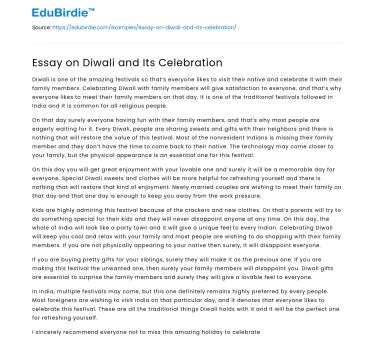Introduction
Diwali, also known as the Festival of Lights, is one of the most prominent and widely celebrated festivals in India, with growing recognition worldwide. Traditionally observed by millions of Hindus, Sikhs, Jains, and some Buddhists, Diwali symbolizes the triumph of light over darkness, knowledge over ignorance, and good over evil. The festival's origins are embedded in ancient Indian scriptures and mythologies, such as the Ramayana and Mahabharata, which recount tales of victory and the return of deities after defeating malevolent forces. This essay aims to explore the multifaceted celebration of Diwali, examining its cultural, social, and economic implications. By understanding these dimensions, we can appreciate the festival's enduring significance and its evolving role in contemporary society.
Cultural Significance and Traditions
Diwali is a cultural beacon that embodies rich traditions, each contributing to its vibrant tapestry. The festival spans five days, each with its unique customs and rituals. The first day, Dhanteras, marks the beginning of Diwali and is traditionally associated with wealth and prosperity. People clean their homes and purchase new items, especially gold and silver, symbolizing abundance and good fortune. The subsequent days, including Naraka Chaturdashi and Lakshmi Puja, are filled with rituals that emphasize cleanliness, illumination, and the worship of deities like Lakshmi, the goddess of wealth, and Ganesha, the remover of obstacles. These practices reflect a deep-seated belief in spiritual renewal and prosperity.
Save your time!
We can take care of your essay
- Proper editing and formatting
- Free revision, title page, and bibliography
- Flexible prices and money-back guarantee
A central element of Diwali is the lighting of diyas (oil lamps) and fireworks, which symbolize the dissipation of evil and ignorance. As the legend goes, the people of Ayodhya lit oil lamps to celebrate the return of Lord Rama, Sita, and Lakshmana after 14 years of exile. This tradition continues to illuminate homes and streets, creating a mesmerizing spectacle that unites communities in shared joy and reverence. Additionally, Rangoli, intricate designs made from colored powders, adorns entrances to homes, embodying the artistic expression and welcoming spirit of the festival. According to anthropologist Dr. Vidya Dehejia, "Diwali's rituals serve as a reminder of the cultural heritage and the values of generosity and hospitality that have shaped Indian society for centuries."
Social and Economic Impact
Diwali's impact extends beyond cultural and religious dimensions, significantly influencing social and economic spheres. Socially, the festival fosters community bonds and family reunions, as people gather to celebrate and share festive meals. The exchange of sweets and gifts is a common practice that reinforces ties and expresses goodwill. In this context, Diwali acts as a catalyst for social cohesion and inclusivity, transcending religious and ethnic boundaries. However, it is essential to acknowledge the counter-argument that the commercialization of Diwali has, in some instances, overshadowed its traditional values. The increasing emphasis on consumerism can detract from the festival's spiritual essence, prompting calls for a balanced approach that honors its cultural roots.
Economically, Diwali is a period of heightened economic activity, often compared to the Western Christmas in terms of retail sales and consumer spending. The festival season witnesses a surge in the demand for consumer goods, textiles, and jewelry, providing a significant boost to various sectors. According to a report by the Confederation of Indian Industry (CII), Diwali contributes substantially to India's GDP, with retail sales during the festival accounting for a considerable percentage of annual revenue for many businesses. This economic stimulation has a ripple effect, benefiting small businesses and artisans, particularly those involved in traditional crafts. Nonetheless, the environmental impact of Diwali, especially from fireworks, poses challenges that necessitate sustainable practices.
Diwali in the Global Context
As Diwali gains recognition on the global stage, its celebration transcends geographical and cultural boundaries. The Indian diaspora plays a crucial role in promoting Diwali in various countries, where it is increasingly acknowledged alongside traditional Western holidays. Events such as Diwali celebrations in Times Square, New York, and Trafalgar Square, London, exemplify the festival's growing international appeal. These events not only celebrate Indian culture but also promote cross-cultural understanding and diversity. According to cultural historian Professor Sunil Khilnani, "Diwali's global resonance speaks to its universal themes of light and renewal, which resonate with people from diverse backgrounds."
However, the globalization of Diwali also raises questions about cultural appropriation and authenticity. While the festival's internationalization fosters inclusivity, it is crucial to maintain its cultural integrity and avoid superficial representations that dilute its significance. Efforts to educate others about Diwali's historical and religious contexts can help preserve its authenticity while embracing its global evolution. In this regard, Diwali serves as a platform for cultural diplomacy, fostering dialogue and mutual respect among nations.
Conclusion
In conclusion, Diwali is a multifaceted festival that encompasses rich cultural, social, and economic dimensions. It is a celebration of light and knowledge, rooted in ancient traditions yet continually evolving to reflect contemporary values. While Diwali fosters community bonds and stimulates economic growth, it also presents challenges that necessitate a balanced approach to sustainability and cultural preservation. As Diwali gains global recognition, it serves as a testament to the universal appeal of its themes and the enduring power of cultural festivals in fostering understanding and unity. By appreciating Diwali's complexities, we can celebrate its significance and ensure its continued relevance in an increasingly interconnected world.






 Stuck on your essay?
Stuck on your essay?

